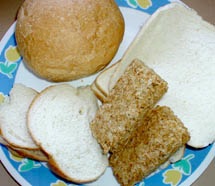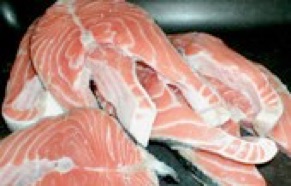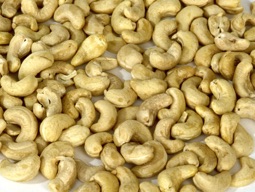Food allergy: specific foods

IMPORTANT The information provided is of a general nature and should not be used as a substitute for professional advice. If you think you may suffer from an allergic or other disease that requires attention, you should discuss it with your family doctor. The content of the information articles and all illustrations on this website remains the intellectual property of Dr Raymond Mullins and cannot be reproduced without written permission.
Summary
Food is the most common cause of severe allergy in young children (less than 5 years) attending childcare and preschool. Common food allergens include cows milk, soy protein, egg, peanut, tree nuts, seafood and sesame seed. Allergic reactions to seafood are uncommon in very young children, but do occur. The most common triggers in adults are peanut, tree nuts and seafood, but a wide variety of different foods can trigger reactions.
Cows Milk Allergy
This is one of the commonest allergies early in life, occurs in ~ 1-2% infants, often first experienced when a baby is weaned and put onto cow’s milk formula. Cow’s milk allergy means that ALL dairy products are off limits, as the allergy is to several proteins, not fat and not lactose (a sugar). Since similar proteins are also present in goat’s milk, “A2 milk” and some other mammalian milks, these are not adequate substitutes. Dairy products may appear on labels under different names such as casein, sodium caseinate, whey powder, cheese protein, milk, non-fat milk solids, milk solids and lactose. It should be noted that lactose used in medicines is highly purified pharmaceutical grade lactose and is highly unlikely to have contaminating milk protein. Foods containing milk protein includes many margarines, vegetarian cheese, crumbed meats in batter, sausages, pastries, some baby foods, custards, coffee whiteners, lollies and chocolate, cakes and slices, cheese sauces, glazed or mashed vegetables, and some soups. Some herbal medicines (eg bovine colostrums) and even some sports drinks contains cows milk proteins too!
Sesame seed
Allergic reactions to sesame seed are not rare. Sesame seed allergy has been estimated to affect around 0.8% of Australian infants aged 12 months in the Healthnuts study published in early 2011. The major sources of accidental exposure are those of Turkish and Middle Eastern foods such as hummus and tabouli or tahini, sesame paste, Greek deserts & bread rolls & dips.
Soy Allergy
This is also a common allergy of infancy, often first experienced when a baby is switched from cow’s milk because of allergy to dairy products. Indeed, around 10-20 per cent of cow’s milk allergic infants are estimated to allergic to soy as well. Other names for soy include soya, soy flour, soya protein, vegetable gum, textured vegetable protein, hydrolysed vegetable protein, lecithin, bean curd, soya bean paste (Miso, Tempeh), and tofu. Soybeans will often be present in salads, canned beans, and some casseroles. Soy flour is often added to baked goods including bread, batters, cereals, sausages, and as a binder in small goods. Lecithin is an emulsifier (322) found in many foods such as chocolate, margarine, and carob. Occasionally, very soy-sensitive subjects might react to these as well.
Egg Allergy
Egg allergy is most common in the first 5 years of life, after (for example) eating custard or licking uncooked cake batter. Allergy to raw egg has been estimated to affect 8.9% of Australian infants aged 12 months in the Healthnuts study published in early 2011. 80% of these children, however, were able to eat egg baked into cake. Allergens are in the egg white and yolk, and in other eggs like duck eggs too. Other names that indicate the presence of egg include egg yolk and egg white, albumen, egg powder or solids. Egg-derived lysozyme may also be present in some cheeses. Common foods containing egg include malted drinks, custards, soufflés, meringues, mousse, glazed rolls or pastries, some soups and sauces (e.g. Hollandaise), icing, expensive ice-cream, chocolate soft centres, rissoles or meat loaf (used as a binding agent), cakes and slices, macaroons, dessert mixes (waffles, pavlova mix, confectionery etc), expensive icecreams and soft centred chocolates. Cooked egg is sometimes better tolerated than raw egg. Those with egg allergy are NOT at increased risk of allergic reactions to the MMR vaccine. There is a small risk with the flu vaccine, but then again, one rarely gives young children this vaccine anyway. A common question is about the “chickenpox” vaccine. This genetically engineered vaccine is not grown on eggs and has NOTHING to do with chickens or egg! Even though the flu vaccine contains tiny traces of egg, studies of over 4000 egg allergic individuals have shown that > 98% can tolerate the vaccine. Australian guidelines are published at: http://www.allergy.org.au/content/view/27/8/#a0
Allergy to Peanut and tree nuts
Peanut allergy has been estimated to affect 3% of Australian infants aged 12 months in the Healthnuts study published in early 2011. Tree nut allergy seems to be less common, perhaps 1% of children but there are currently no accurate estimates. Nuts are also hard to avoid. In two recently published adult surveys, 50 % of peanut allergic subjects had accidently had them in the previous 12 months, and 75 % had been exposed in the previous 5 years. Peanuts in particular are more difficult to avoid than other nuts because they are cheaper than tree nuts (such as almonds, brazil nuts, cashews etc), they are used in many manufactured foods (peanut butter, chocolates, icecreams,), and may occur as contaminants (e.g. where different biscuits or chocolates are made on the same production line). Often the first reaction often occurs when the child is given peanut butter on toast. Such patients will occasionally even complain of distress if packets of nuts are opened in their presence. Fortunately, these are the exception rather than the rule. Almost all serious allergic reactions to this and other foods need the food to get into the mouth, NOT from touching alone, although contact rashes can occur.
By law, if a food has peanut or tree nuts added to it, the label should contain the word “nuts” on the ingredient list, although the type of nut may not be specified. Some manufacturers will label their products as possibly containing traces of nuts. In such situations, multiple products may be made on the same production line and cross-contamination with traces of nuts cannot be guaranteed. Types of foods containing peanuts or tree nuts include peanut butter, mixed nuts, some Asian foods, Indian food, sate, curry paste, some commercial pasta sauces, some pestos (which may have other nuts as well as pine nuts), dips and savouries, shop-purchased slices or cakes, dips, biscuits, some cereals, chocolates, muesli or health bars, and almond icing and marzipan. Highly purified peanut oil normally contains no evidence of allergen, but as it is hard to find out how pure it is, it is probably best avoided. Some patients avoid other legumes (such as soy or string beans) because peanut is a legume too. This is unnecessary in most cases. Many forget that almond icing or marzipan is nut-derived!
Patients allergic to peanuts are not always allergic to tree nuts, as the proteins are different. Occasionally nut products or oils have been used as unlabelled ingredients in cosmetics such as massage oils or even toothpaste and moisturisers. For example, the term Arachis oil on the label is the scientific name for peanut. One of the hardest issues to deal with is the common labeling of pre-packaged food as “may contain traces of…”. The risk is low but not zero, if accidental cross-contamination of food has occurred on the production line. Nonetheless, unlabelled foods pose a much higher risk.
More on nut oils
A number of tree nut oils are used in commercial products (eg. macadamia, almond), including body oils, skin bronzing oils, some lipsticks, massage oil, sunscreens, shampoos and conditioners and even baby oils and occasionally toothpaste. Even some baby oils and mositurisers and nappy rash creams have added nut oils in them, so read the labels!
Chocolate Treats
Having to avoid chocolates causes problems, particularly at Easter. Kinnertons (UK) have a range of dairy, nut & egg free chocolates, sold in Australia through major retailers (http://www.kinnerton.com/nutfree.html). Also Sweet William chocolates (www.sweetwilliam.com.au). The ”Chocolate Box” sells some dairy free choc: www.chocolatebox.com.au/alternatives.shtml. Sweet William chocolates are peanut free (but can contain almonds). tel 1300 656 223 or www.sweetwilliam.com.au
Allergy to wheat & cereals usually resolve quickly
Allergic reactions to wheat and other cereals are most common in infants and usually resolve within the first few years of life. Whilst some children develop hives, other common symptoms are those of worsening atopic eczema. This usually occurs within a few hours of eating. Occasionally delayed reactions occur after the food is eaten regularly over several days, resulting in eczema or sometimes diarrhoea or poor weight gain. In this situation, skin allergy testing is often negative and the diagnosis rests on temporary elimination from the diet followed by deliberate challenge under careful medical supervision. Wheat and cereal allergy is occasionally seen for the first time in adults. 20% of those with wheat allergy are allergic to other cereals as well.
Seafood allergy
Seafood allergy can involve sensitivity to "scaly fish" (eg. tuna, cod, salmon), to shellfish [including crustaceans like crab, prawns, Balmain bugs, scampi or lobster or molluscs like scallops, oyster, mussels]. Seafood allergy seems to be more common in adults than children, but when it does occur, usually remains as a life-long problem, with only 1 in 5 growing out of their allergy. Patients are usually allergic to 1 or 2 proteins that may be present in multiple species. Allergy to one fish often results in allergy to most other fish in the same way that allergy to one crustacean usually means that all must be avoided. Most patients are allergic to only one seafood group. Sources of accidental exposure that may be unexpected include anchovies in Caesar salad or pizzas, seafood pizza or Worstershire sauce. A related article on seafood allergy examines this issue in greater depth.
Red Meat allergy
Meat is a major source of protein in Western diets, and allergic reactions to beef and chicken are the most common. Unfortunately, recent studies suggest that individuals allergic to one meat may have sensitivities to similar allergens present in multiple mammalian meats and sometimes gelatine as well (a meat-derived allergen). Observations of a relationship between adult onset red meat allergy and prior tick bite reactions has been noted by researchers in Australia and the USA. The mechanism is an active area of research.
Reactions to other foods are less common
Reactions to a diverse range of food and plant-derived products such as spices, vegetable gums, gelatine, herbal remedies (eg. Royal Jelly, Echinacea), vegetables and meats have all been described.
Oral Allergy Syndrome
About 1 in 10 people with allergy to some grass or tree pollens in the ACT (this condition is reported more often in Europe) will complain that some uncooked vegetables or fresh fruits and nuts will make their mouth and throat itchy or swell. This is known as Oral Allergy Syndrome. In this condition, people are allergic to proteins that are present in pollens as well as these foods. If the food is heated, the protein is often destroyed. This is why they can usually eat the cooked food without a problem. More serious allergic reactions sometimes occur, particularly if exercise is undertaken soon after eating a lot of this type of food. Occasional unlucky people are allergic to many fruit and vegetables, have to cook them well and take a multivitamin.
Allergic reactions to inhaled food are uncommon
Allergic reactions to food in the form of fine dust are uncommon, and mainly occur in food handlers. Examples include asthma induced by the fine dust of coffee or soy beans in processing plants, seafood allergens in some factories or wheat dust in bakeries. Sometimes people with severe food allergies find that even the smell of foods can trigger symptoms. Fortunately, this is a relatively rare complaint.
The natural history of food allergy
Information on the natural history of food allergy is evolving, and may even be changing. Around 80 % of children allergic to cows milk and soy will be able to tolerate it by the age of 3-6 years. Egg allergy is generally longer lasting, with about 80 % having grown out of it by age 8-16 years. Unfortunately, those allergic to nuts or seafood rarely seem to grow out of their problem (exceptions do occur, perhaps around 20 %), leading to life-long avoidance strategies. In nut allergic children, the presence of other food allergies and other allergic disease like asthma or eczema, make it much less likely that the nut allergy will resolve with time.
Pet food can trigger allergies
Pet food can also contain allergens like dairy and wheat and egg. While children may not eat the food, the dog or cat may lick them, triggering a local reaction.
Weblinks
Anaphylaxis Australia http://www.allergyfacts.org.au
Food Allergy Network, USA http://www.foodallergy.org
MedicAlert Foundation http://www.span.com.au/medic
Allergy Kidz Ware. Clothes labels and logos for kids with food allergy. http://www.allergykidzware.com.au
“My First Allergy Book”: www.myfirstallergybook.com
Last reviewed December 2011


